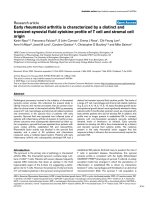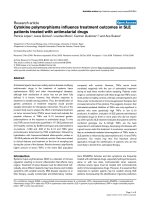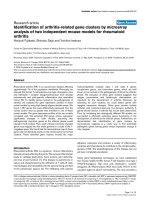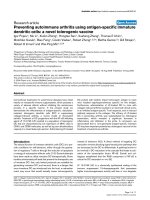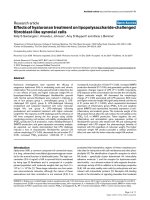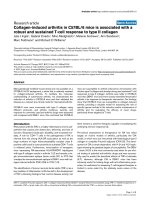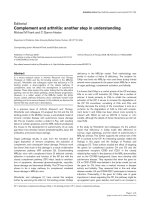Báo cáo y học: "Effective rheumatoid arthritis treatment requires comprehensive management strategies" docx
Bạn đang xem bản rút gọn của tài liệu. Xem và tải ngay bản đầy đủ của tài liệu tại đây (42.44 KB, 2 trang )
Available online />Page 1 of 2
(page number not for citation purposes)
Abstract
Work by Lee and colleagues has shown that decreased sleep
quality and increased psychiatric distress increase pain sensitivity
at both articular and nonarticular sites in rheumatoid arthritis (RA)
patients. This work is consistent with prior studies showing that
factors independent of RA disease activity can influence RA out-
come measures. Owing to increasing pressure on rheumatologists
to use outcome measures to inform treatment decisions, the work
by Lee and colleagues highlights the need for comprehensive RA
management strategies to understand and address the human
factors that influence outcomes measures. Such strategies will
ensure appropriate use of increasingly expensive therapies while
maximizing patient satisfaction and reimbursement.
Newly published work has important implications for the care
of rheumatoid arthritis (RA) patients [1]. In their study, Lee
and colleagues correlated pain sensitivity at articular, peri-
articular and muscle sites with measures of RA disease
activity as well as with measures of sleep quality and psy-
chiatric distress. Interestingly, the authors found pain sensi-
tivity was not influenced by the C-reactive protein (CRP)
level. While correlations between pain sensitivity and other
disease activity measures existed, the associations varied by
site. As would be expected, pain sensitivity correlated with
the swollen joint count only at articular sites. The 28-joint
disease activity score (DAS28)-CRP, however, correlated
with pain sensitivity at both articular and periarticular sites –
probably due to the fact that the tender joint count (TJC) was
associated with pain sensitivity at all sites. Decreased sleep
quality was also associated with pain sensitivity at all sites,
but the psychiatric distress level correlated with pain
sensitivity only at articular and periarticular sites. While the
authors found that patients with concomitant RA and
fibromyalgia syndrome (RA-FMS patients) had increased pain
sensitivity at all sites associated with increased TJC and
decreased sleep quality, the inverse relationship between
sleep quality and pain sensitivity at all sites remained when
the data were reanalyzed after excluding RA-FMS patients.
The psychiatric distress levels were also similar between RA
patients with and without FMS, indicating that the increase in
pain sensitivity associated with psychiatric distress was
independent of the presence of FMS.
The tendency for the TJC to be elevated by conditions
independent of RA disease activity presents a challenge for
RA disease management. The DAS28-CRP is calculated by a
weighted combination of CRP, swollen joint count and TJC
[2]. The relative weighting of each component was
designated to coincide with clinical decision-making by
rheumatologists, specifically making a treatment change. The
weighting of the TJC is twice that of the swollen joint count in
the DAS28-CRP formula, indicating treatment decisions are
biased more by the number of tender joints than by the
number of swollen joints. This bias can lead to overaggres-
sive treatment of RA patients with joint tenderness arising
from factors independent of RA disease activity. The ten-
dency for DAS28 scores to overestimate RA disease activity
in RA-FMS patients has been demonstrated previously [3].
FMS independently increases DAS28 scores by almost a full
point, resulting in the overestimation of RA disease activity in
63% of RA-FMS patients. Consistent with the findings of Lee
and colleagues, the overestimation of disease severity in RA-
FMS patients was due to higher TJC and perceived disease
activity scores. RA-FMS patients also had significantly worse
scores on other outcome measures used to assess disease
severity, including the health assessment questionnaire and
the Medical Outcomes Study Short Form 36.
Editorial
Effective rheumatoid arthritis treatment requires comprehensive
management strategies
Chad S Boomershine
Division of Rheumatology and Immunology, Vanderbilt Center for Molecular Neuroscience, Vanderbilt Center for Integrative Health, Vanderbilt
University, 1161 21st Ave S, T3219 MCN Nashville, TN 37232-2681, USA
Corresponding author: Chad S Boomershine,
Published: 21 December 2009 Arthritis Research & Therapy 2009, 11:138 (doi:10.1186/ar2872)
This article is online at />© 2009 BioMed Central Ltd
See related research by Lee et al., />CRP = C-reactive protein; DAS28 = 28-joint disease activity score; FIBRO = Fatigue, Insomnia, Blues, Rigidity, Ow!; FMS = fibromyalgia syn-
drome; RA = rheumatoid arthritis; TJC = tender joint count.
Arthritis Research & Therapy Vol 11 No 6 Boomershine
Page 2 of 2
(page number not for citation purposes)
Given the increasing pressure on physicians from regulatory
agencies and insurance companies to base treatment
decisions on outcome measures [4], the work by Lee and
colleagues highlights the importance of an individualized,
comprehensive approach to RA management [1]. Experience
has shown that many RA patients present with joint
tenderness and synovitis accompanied by a variety of
symptoms I have previously characterized in FMS with the
FIBRO mnemonic – Fatigue, Insomnia, Blues (depression
and/or anxiety), Rigidity (muscle and joint stiffness), Ow!
(pain and work disability) [5]. While FIBRO symptoms resolve
along with synovitis in response to antirheumatic therapies in
some cases, many patients remain symptomatic despite the
lack of objective evidence for synovitis resulting in persis-
tently poor outcome measure scores. Outcome measure
scores in these patients only improve when the underlying
cause(s) of their FIBRO symptoms are understood and
addressed, requiring the use of nonrheumatic therapies as in
FMS [5]. Corroboration for these observations comes from
work showing that RA-FMS patients have increased RA
disease severity and are resistant to standard therapy [6]. The
presence of FMS is not required, however, for associated
symptoms to impact RA disease severity. Many RA patients
without FMS report pain at nonarticular sites and suffer from
persistent pain even when inflammation appears well
controlled [7], and sleep disturbance has been shown to
worsen pain severity in RA patients independent of the
coexistence of FMS [8].
As physicians, we have access to increasingly powerful
therapies to combat disease. With great power, however,
must also come great responsibility. We must be prudent in
our use of new therapies as they can have enormous costs,
both financial and human, to our patients and society. All too
often we assume patients who fail to respond to therapy
merely require more or stronger treatments. The work by Lee
and colleagues reminds us that it is important to consider
human factors existing outside the primary disease that can
influence treatment outcomes [1]. In the past, some
physicians have avoided consideration of these factors due to
the assumption that such considerations were not necessary
for disease management. However, use of patient satisfaction
surveys in determining physician reimbursement and societal
pressures for improved utilization of healthcare dollars make
identification and management of FIBRO symptoms
increasingly important [9]. While existing questionnaires such
as the modified VAS Fibromyalgia Impact Questionnaire [5]
and the Symptom Impact Questionnaire (SIQR) [10] can be
used to rapidly identify FIBRO symptoms, physicians must
acknowledge the necessity of treating these symptoms in
order for the implementation of comprehensive treatment
strategies that improve patient care to occur.
Competing interests
CB has received funding from Pfizer Inc., Eli Lilly Inc. and
Forest Laboratories, Inc.
References
1. Lee YC, Chibnik LB, Lu B, Wasan AD, Edwards RR, Fossel AH,
Helfgott SM, Solomon DH, Clauw DJ, Karlson EW: The relation-
ship between disease activity, sleep, psychiatric distress and
pain sensitivity in rheumatoid arthritis: a cross-sectional
study. Arthritis Res Ther 2009, 11:R160.
2. Prevoo MLL, Van’t Hof MA, Kuper HH, Van Leeuwen MA, Van De
Putte LBA, Van Riel PLCM: Modified disease activity scores
that include twenty-eight-joint counts. Development and vali-
dation in a prospective longitudinal study of patients with
rheumatoid arthritis. Arthritis Rheum 1995; 38:44-48.
3. Ranzolin A, Tavares Brenol JC, Bredemeier M, Guarienti J, Rizzatti
M, Feldman D, Xavier RM: Association of concomitant fibro-
myalgia with worse disease activity score in 28 joints, health
assessment questionnaire, and short form 36 scores in
patients with rheumatoid arthritis. Arthritis Rheum 2009, 61:
794-800.
4. Wolfe F, Michaud K, Pincus T, Furst D, Keystone E: The disease
activity score is not suitable as the sole criterion for initiation
and evaluation of anti-tumor necrosis factor therapy in the
clinic: discordance between assessment measures and limi-
tations in questionnaire use for regulatory purposes. Arthritis
Rheum 2005, 52:3873-3879.
5. Boomershine CS, Crofford LJ: A symptom-based approach to
pharmacologic management of fibromyalgia. Nat Rev
Rheumatol 2009, 5:191-199.
6. Wolfe F, Michaud K: Severe rheumatoid arthritis, worse out-
comes, comorbid illness, and sociodemographic disadvan-
tage characterize RA patients with fibromyalgia. J Rheumatol
2004, 31:695-700.
7. Buskila D, Sarzi-Puttini P: Fibromyalgia and autoimmune dis-
eases: the pain behind autoimmunity. Isr Med Assoc J 2008,
10:77-78.
8. Wolfe F, Michaud K, Li T: Sleep disturbance in patients with
rheumatoid arthritis: evaluation by medical outcomes study
and visual analog sleep scales. J Rheumatol 2006, 33:1942-
1951.
9. Teisberg EO, Wallace S: Creating a high-value delivery system
for health care. Semin Thorac Cardiovasc Surg 2009, 21:35-42.
10. Bennett RM, Friend R, Jones KD, Ward R, Han BK, Ross RL: The
Revised Fibromyalgia Impact Questionnaire (FIQR): validation
and psychometric properties. Arthritis Res Ther 2009, 11:
R120.


